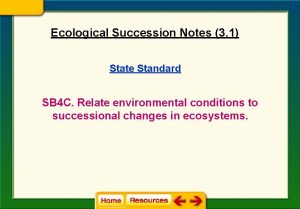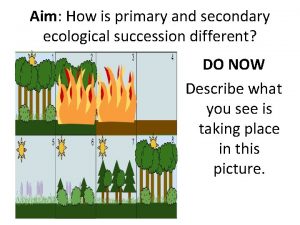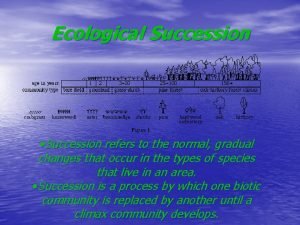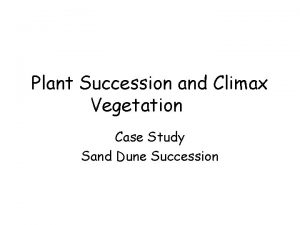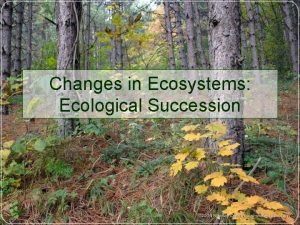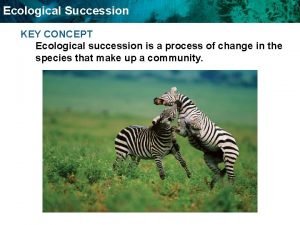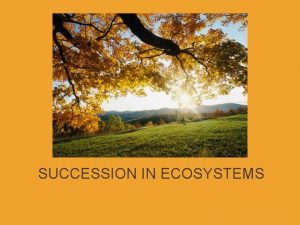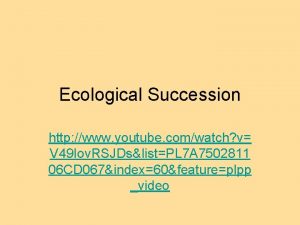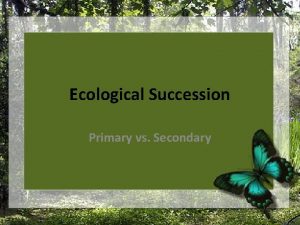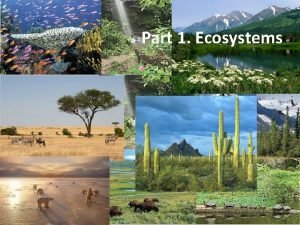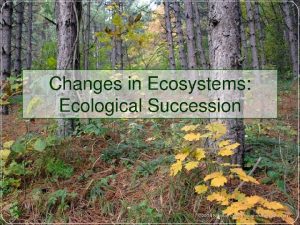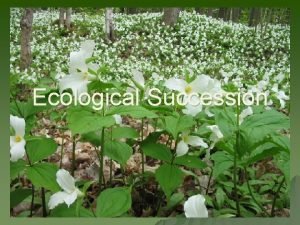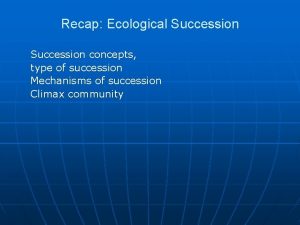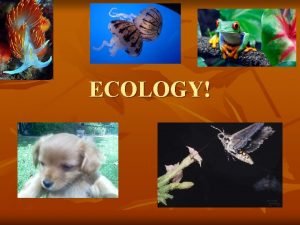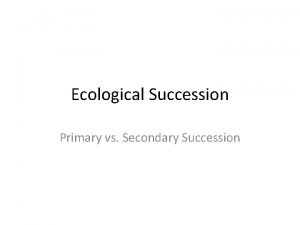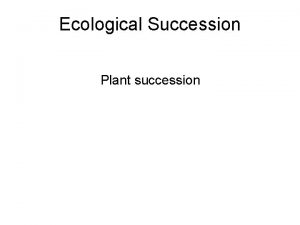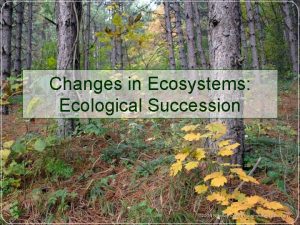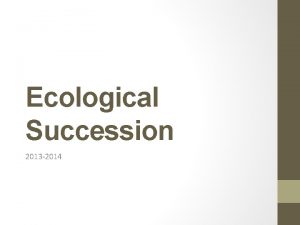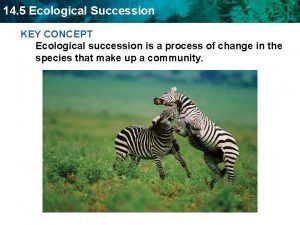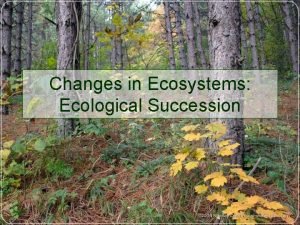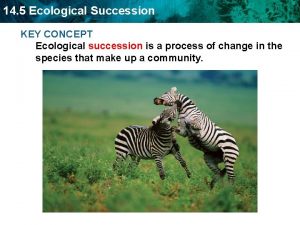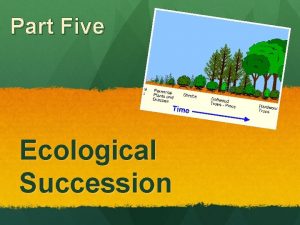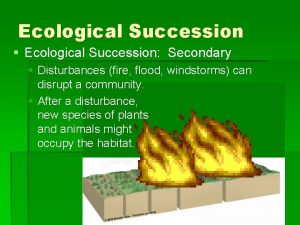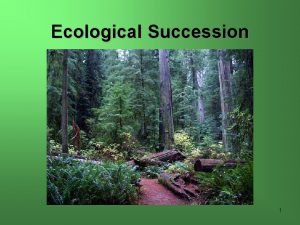Ecological Succession What is Ecological Succession Succession is
















- Slides: 16

Ecological Succession

What is Ecological Succession? Succession is a series of environmental changes, occurs in all ecosystems. Nothing remains the same and habitats are constantly changing. The stages that any ecosystem passes through are predictable.

Why Does Succession Occur? o Succession takes place because the environmental conditions in a particular place change over time. o Each species is adapted to thrive and compete best against other species under a very specific set of environmental conditions. If these conditions change, then the existing species will be replaced by a new set of species which are better adapted to the new conditions.

Types of Succession There are two types of succession: o. PRIMARY o. SECONDARY

Primary Succession o succession that occurs on surfaces where no soil exists. For example, formation of islands following a volcanic eruption. o Click for video THINK PRIMARY MEANS FIRST SO THIS IS THE FIRST TIME LIFE GROWS

Secondary Succession o changes that affect an existing community without removing the soil. An example would be the burning and reforestation following a wildfire. Click for video

Key Terms o Pioneer species: the first species to colonize the area. For example, lichen growing on rock o Climax community: the final stage of succession when the ecosystem is supporting the largest and most complex community of plants and animals it can. It will not change much more.

Succession is not just about plants. Its about what animals the ecosystem can sustain too!

More Clips to help you Understand… o Mr. Anderson clip: o Song: o Crash Course- Ecological Succession o Amoeba Sisters

Succession Example #13 Secondary ____ : The Heathland Project is an area that was cleared of mixed woodland, with an under storey of rhododendron, in 1993. It was then treated with Roundup, a biodegradable herbicide, to clear the site of all existing vegetation. The site has since been divided into nine different strips and it has been allowed to regenerate naturally. Different management methods are used on the strips, with the aim of determining which is the best method for regenerating Heathland. One of the strips has been left untouched.

Succession Example #14 Secondary ___________: Duke University describes how abandoned farmland eventually became the Duke Forest. This farmland was overworked so that its soils no longer had the nutrients necessary to create healthy crops. After the farmland was abandoned, horseweed and crabgrass began to grow, followed by asters and larger plant species. After three years of abandonment, grass scrub began to take over followed by a few pine trees. From the 19 th to 30 th year after abandonment the land was a pine forest. The pine forest matured and began to transition to a hardwood forest around year 70. After a hundred years of abandonment what was once farmland had become an oak-hickory forest.

Succession Example #15 Primary _______: At Acadia National Park in Maine, the following can be observed in different stages; first to appear on the bare rocks are lichens and algae. These secrete acids which begin to extract nutrients from the rock and which form tiny cracks which are widened by freezing and thawing. As the cracks widen they trap enough organic material and moisture for mosses to take hold. Larger cracks have enough soil to support grasses and small shrubs.

Succession Example #16 Primary _________: On the west coast at Mt. Rainier in Washington, the lichens are the first to appear on the rock surface. More obvious are the mosses, grasses and small plants like flowers. Each stage accumulates soil and organic material that facilitates the growth of the next stage. Once again, on this mountainside, the coniferous forest is the climax community.

Succession Example #17 Secondary __________: In the drought year of 1988, huge fires swept through Yellowstone National Park. After years of fire suppression in the park, the forest floor was loaded with potential fuel, and the resulting fire burned hotter than it would have if more frequent, patchy fires had been allowed to take their natural course.

Succession Example #18 Secondary ____________: The gopher tortoise builds a large burrow in the sands of the Florida Scrub. The burrow itself becomes a refuge for a number of animals other than the tortoise; owls, snakes, frogs, crickets and a host of other animals are known to use the burrows. The spoils on the edge of the burrow (above) are composed of sand dug from the burrow. This sand often bears nutrients that heavy summer rains had leached underground, out of reach of the roots of most plants. The spoil pile, then, represents "new" nutrient rich soil, and plants quickly grow there.

Succession Example #19 Secondary __________: In 1980, Mt. St. Helens in Washington erupted, essentially destroying all life in a large blast zone. Trees were killed and the ground was covered with ash. In some places, such as the protected side of a knob, while the mature trees were killed the soil was not sterilized as it was in other places. This meant that seeds could germinate and begin to replace the forest more rapidly than was possible in areas where no seeds survived. While plant life is trying to re-establish itself on the lava flow, which is a very inhospitable environment as it is hot and dry would be considered: Primary ___________
 Ecological succession succession of a pond
Ecological succession succession of a pond Ecological succession succession of a pond
Ecological succession succession of a pond Describe primary and secondary succession
Describe primary and secondary succession When does a climax community change
When does a climax community change Ecological succession case study
Ecological succession case study Secondary succession examples
Secondary succession examples Steps of secondary succession
Steps of secondary succession Presidential succession def
Presidential succession def If there is no struggle there is no progress examples
If there is no struggle there is no progress examples Youtube ecological succession
Youtube ecological succession Primary vs secondary succession
Primary vs secondary succession Objectives of ecosystem
Objectives of ecosystem Types of succession
Types of succession Compare primitive communities to climax communities.
Compare primitive communities to climax communities. Climax community
Climax community Shrubland
Shrubland Eutrophication comic strip
Eutrophication comic strip

